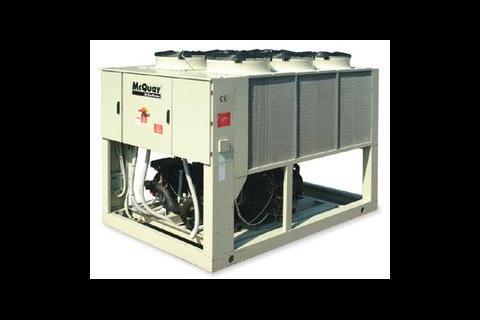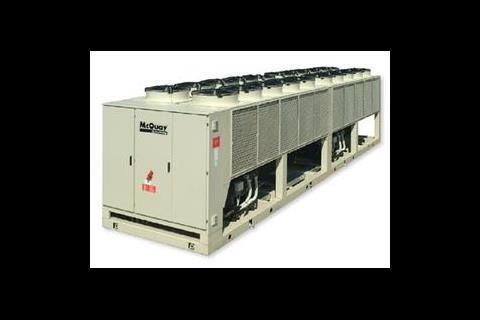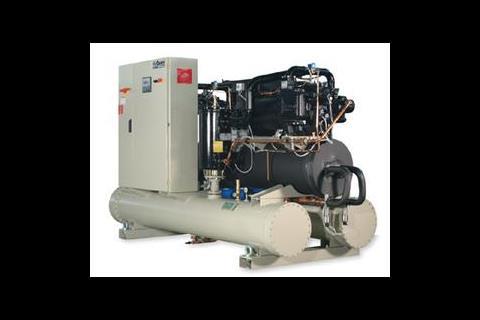Davis Langdon Mott Green Wall collaborates with chiller specialist McQuay to look at the latest trends in the development of air and water cooled chillers and examine the capital costs of the machines currently on the market
Chiller selection has traditionally been driven by several key factors, including cooling requirement, plant space availability, efficiency, noise and refrigerant choice.
With the publication of the revised Part L of the ��ɫ����TV Regulations, and its emphasis on chiller coefficient of performance (CoP), the increase in chiller efficiencies is now becoming a key factor in the selection process, with product development being driven largely by this factor.
Chiller efficiency
Water-cooled units operate at lower condensing temperatures and are generally more efficient than air-cooled chillers. However, the power loads of cooling towers and pumps need to be taken into consideration, as these will reduce the overall efficiency of a water-cooled system, particularly on large or tall buildings.
The relative efficiencies of a range of chiller installations are summarised in Table 1. The CoP indicates the efficiency of converting input energy into output cooling, and does not account for energy requirements beyond the chiller, such as pumps and cooling towers.
Efficiency is an important consideration when there are limits on available electrical power, particularly where an increased cooling load has to be handled with little or no increase in power consumption. Where there are power limits, high-efficiency centrifugal chillers can be selected to closely match available power, in preference to air-cooled machines which may potentially have a greater power requirement.
The energy-efficient technologies that are currently available, or in development, can be summarised as follows:
n Inverter-driven compressors. These significantly improve part-load efficiency. This technology has been available for years in smaller capacity compressors, typically up to 30 kW, in small chillers and VRF units, and more recently in centrifugal compressors. Several manufacturers are now developing large capacity screw compressors, up to 300 kW.
n Compressor technology. A further advancement here has been the development of the turbo core compressor, which is an oil-less variable speed machine. This has been developed independently, and so is available for use by all the manufacturers. It gives a significantly better part-load performance than conventional compressors, but at a significantly higher cost.
n Economisers. This technology has typically been used on industrial large capacity plants and is now being used by several manufacturers, mainly on air-cooled commercial machines. The economiser is built into the unit and increases the refrigerant sub-cooling through a plate heat exchanger, which can increase the efficiency of the machine by 15-20% and it's capacity by about 5-6%. This increase in capacity may be particularly cost effective in the upper size range, where to achieve the required performance, an additional compressor may otherwise have to be used.
n Compressor oil management. Developments here allow head pressure relief to be varied. Most commercial screw compressors rely upon the pressure differential across the compressor for oil feed to lubricate and seal. However, reducing the head pressure while maintaining adequate oil flow can lead to significant increases in CoP, particularly at low ambient temperatures.
n Free cooling. This technology is not new and needs to be evaluated on a project by project basis, as a so-called free cooling chiller in the wrong application could cost more to run than a standard machine. Applied to packaged air-cooled chillers, these comprise an auxiliary glycol/air heat exchanger mounted on the outside of the refrigerant condenser coil. The chiller efficiency is compromised when free cooling is not in use, and free cooling is not possible unless the ambient temperature is below the chilled water return temperature, so its use needs to be matched to the application.
n Thermosyphon. Previously used on water-cooled units, some manufacturers are now also starting to use these on air-cooled plant. This uses the natural tendency of a refrigerant to migrate towards an area of low temperature, to satisfy some or all of a building's load at low ambient temperatures without operating the compressors.
n Ongoing development into heat exchanger materials, construction and heat transfer performance. As with all new technologies, the challenge to chiller manufacturers is to provide a balance between higher efficiency and cost.
Cooling requirement
In terms of cooling load, air-cooled package chillers are generally preferred for small applications due to their lower initial cost and ease of installation. Packaged plant, for example, only requires chilled water connections and electrical power. However, on larger installations, water-cooled systems are more cost-effective due to the higher unit capacities of the chillers.
Air-cooled chillers can provide high levels of redundancy due to their modular design. Redundancy can be provided in water-cooled systems by specifying smaller multiple units. However, this will result in a higher overall cost.
Plant space requirements
The plant space requirements for air and water-cooled solutions have implications for capital cost and development efficiency. Air-cooled chillers do not require enclosed plant space and their use will not generally affect development efficiency. However, their specification may be constrained by the space available for a roof level plant compound.
Overall, the space required for a water-cooled system is higher than for an equivalent number of air-cooled chillers - but this can be split between basement and roof, with the result that a roof-mounted cooling tower has a smaller footprint than an air-cooled chiller compound.
For example, to produce a cooling load of 1000 kW, an air-cooled system will require 98 m² at roof level. A water-cooled system would require 115 m², including 65 m² at roof level. While new-build projects may be able to accommodate this spatial requirement, refurbishment schemes, or projects on sensitive sites, space and planning restrictions may often only leave the option of a water-cooled system.
Noise
Where noise is an overriding factor, water-cooled machines are preferred, as cooling towers or dry coolers are generally quieter. However, technology advances have all but eliminated compressor noise for air-cooled packages.
For air-cooled chillers, the noise specification provides an additional challenge in terms of efficiency. For a given condenser area, a higher air volume results in a higher velocity and efficiency, but also a higher noise output as the higher the air velocity across the condenser, the higher the efficiency - but the higher the noise output. This means either increasing the surface area of the condenser, resulting in a machine with a larger footprint, or fitting additional acoustic measures which increase the cost and weight of the machine.
Refrigerants
The refrigerant used is closely linked to the type of compressor specified, with most chiller manufacturers using R134a, R410a and, to a lesser degree, R407c for their machines.
R410a and R407c tends to be used for small capacity scroll compressor machines, with R134a being used on larger size screw and centrifugal compressor machines.
Cost issues
Water-cooled chillers are cheaper to buy than their air-cooled equivalent. However, when the additional cost of installing the condenser water is included, the total costs generally exceed those of air-cooled installations. Typical installation capital costs are provided in Table 2, for a range of buildings up to 30,000 m2. However, on larger projects, in excess of 30,000 m2, the reverse is true, with the combination of the larger water-cooled unit sizes and the condenser water system becoming more cost effective when compared to the greater numbers of air-cooled chillers that are required to satisfy the cooling load.
The running costs of the two types of system are broadly similar. Examined in isolation, water-cooled chillers have lower running costs, but additional costs are incurred by the pumps and cooling towers, which could be significant on tall buildings or projects with complex distribution routes.
The pattern of use will also have a significant impact. Where a system is run at partial load over long periods due to the building load profile, a water-cooled centrifugal system would generally have the lowest running costs.
Key Selection Criteria
For air-cooled package chillers: duty range from 10 kW to 1700 kW; usually multi-compressor over 100 kW; most have positive displacement compressors - mainly screw or scroll.
For water-cooled chillers: duty range from 10 kW to 5000 kW; single and dual compressor options available, dual compressors offer higher efficiencies at part load; can use positive displacement or centrifugal type compressors.
Source
��ɫ����TV Sustainable Design

























